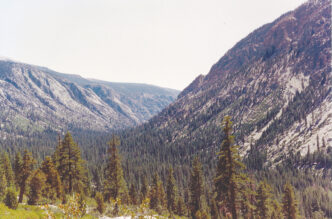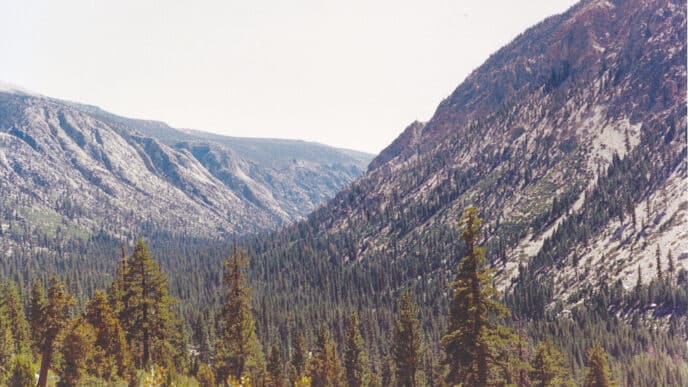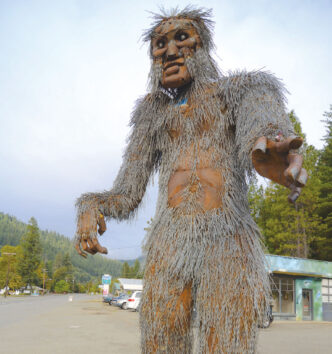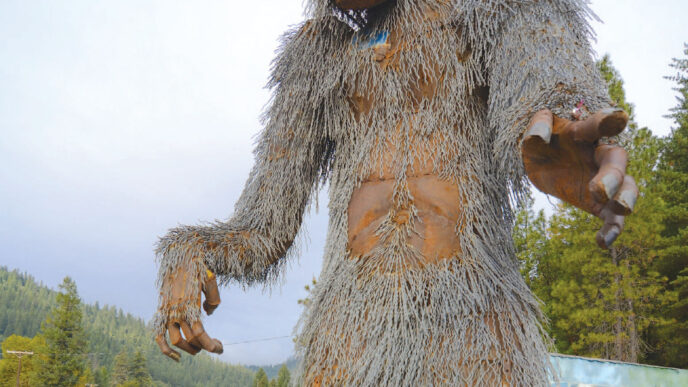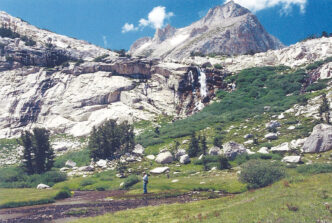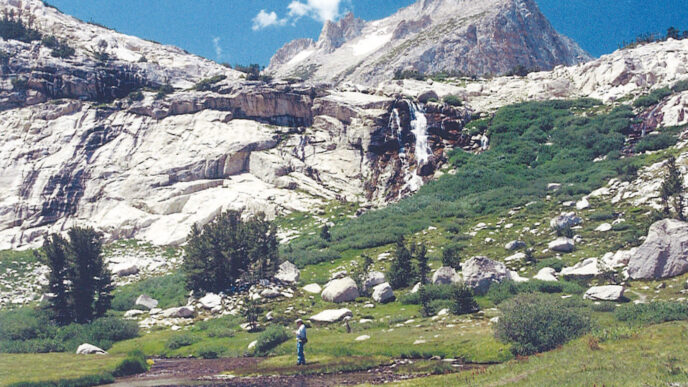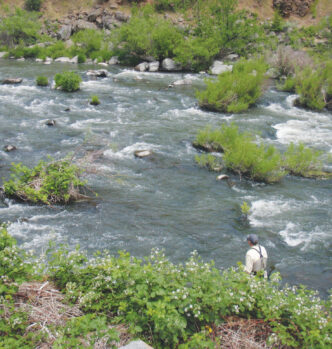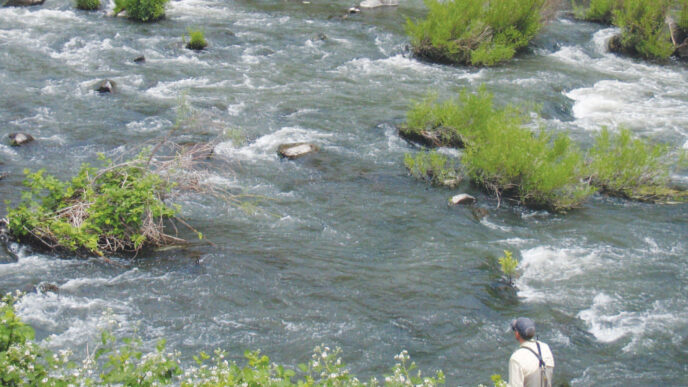The immense california Water Project dammed Big Grizzly Creek in 1967, an act that in turn flooded a large valley seven miles north of Portola, California, at the elevation of 5,600 feet. Thousands of acres of sagebrush and fertile, eastern Sierra grassland were covered with water. A quickly expanding population of aquatic invertebrates and a trout-stocking program featuring primarily Eagle Lake strains of fish resulted in a fantastic fishery characterized by high growth rates and a dense fish biomass — 200 pounds per acre. Shallow flats penetrated by long, tree-studded fingers of higher ground proved to attractive to the fish and therefore to the fly fisher, but the lake could be enjoyed by all types of anglers, and there were water types and room for all. A deeper basin to the east provided both cool-water trout havens in the summer and a winter sanctuary under a frozen lake. The impoundment was named for conservationist and dam proponent Lester T. Davis: Lake Davis.
The California Department of Fish and Game made this their signature trophy trout lake, and upward of three-quarters of a million trout fingerlings were planted each year. These fish grew rapidly in Davis’s fertile waters, without competition except for brown bullheads. A planted fingerling could grow to a plump 14 inches by the end of the following season, and those fish attained the 17-inch range if they survived another year. Twelve more months of growth came to those that survived the onslaught of pelicans and avoided gracing dinner tables, their length extending to 19 inches and beyond. Anglers flocked from far and wide to troll, bank fish, and cast flies.
I first visited Lake Davis in July of 1971. I had four days off from work and was heading for Eagle Lake on a backroads adventure, sleeping in the back of a Chevy El Camino. But a stop in the sleepy railroad town of Portola for provisions proved fortuitous. A small general store provided white gas for my Coleman lantern and stove. New to fly tying, I was enthralled to find a redheaded woman with a white visor tying flies with a bottle of Jack Daniels next to her fly tying bench. She asked me where I was headed.
When she heard that Eagle Lake was my destination, she told me emphatically, “You would do well to camp at Lake Davis and fish here.” I was further directed to get a campsite at Grizzly or Grasshopper on the east side and return to town for the flies that she would tie. She said she would have a map and give me some tips. She added, “Don’t rush. Nothing happens until well after 7:00 P.M. this time of the year.”
I followed Evelyn Gamble’s instructions and returned for my flies and leader material, all the while a bit skeptical. Lake fishing with a fly rod was new to me. Was this a snipe hunt? Did this woman know what she was talking about? Evelyn was working on my order when I returned. I watched her tie her version of the Feather River Country Buzz Hackle.
I left with a dozen flies and a map that directed me over washboard gravel roads to a place called Cow Creek. Evelyn suggested a bottle of cheap wine from her shelves in case the wind blew too hard to fish and told me to wade out no more than waist deep. She told me that the fish would gradually come inshore as the sun went down. More advice included the admonition to check my rear, toward shore, if I heard splashes. Her fly, made with grizzly and brown hackle, was to be cast on a floating line into the waves and retrieved in short strips with intermittent pauses.
I stayed four days, exchanged ideas with Evelyn, was taught some fly-tying tricks, talked the local pharmacist out of pill bottles for insect samples, and came to know the metropolis of Portola. It was an angling epiphany for me. Large and plentiful trout, the likes of which I had never seen before, literally changed my life and launched me on a stillwater trail that knows no end. I’ve been heading to Portola ever since.
Portola was a railroad town because the Western Pacific Feather River route changed crews at nearby Keddie after the tortuous climb up the Feather River Canyon and before hitting the Nevada desert on the east side of Beckwourth Pass. During snow stoppages and other delays on the original Union Pacific route over Donner Pass, the Western Pacific “rented” track space over this lower transSierra crossing. Short of going to Washington State and the Burlington Northern, there was no other crossing, because the Atchison, Topeka, and Santa Fe went farther south through Barstow, Pisgah, and Needles.
The old part of town across the tracks on Commercial Street held a number of 24-hour cafés, railroad hotels, saloons, and several brothels and gaming tables . . . all to take care of train-crew needs. Evelyn’s husband, who was the local Plumas County judge, and the county sheriff weren’t concerned about illicit activities or liquor laws. Portola’s lumber mills were running full tilt, and the economy was good. A famous bartender of sorts was a local character called Snap Applegate. Snap lived in a small trailer up near what is now the Grizzly Country Store. He drank red lightning from a gallon jug on a stump table outside his trailer and in December would take you up into the hills in his old open-air Jeep to cut a fresh Christmas tree. He tended bar all night and told stories of his travels, including years riding the rails. The standout feature of his workingman’s bar was a stuffed alligator that had a swivel in the tip of its tail. Snap would pour you a stiff drink and stir it with the gator’s tail.
Add nearby Frenchmans Reservoir and the Middle Fork of the Feather River, as well as the Lakes Basin, and this was a top-notch angling destination. In the 1970s, 1980s, and 1990s, the Log Cabin in Portola was about the only place to get a decent dinner, if you stuck with steaks and prime rib. Dave Draheim remembers paying $8.95 for an entire prime rib dinner that would choke a horse and six bucks for a marginally drinkable bottle of red. It was a raucous place. Evelyn’s husband held his court there on occasion, and a bit more recently, so did his replacement judge. If you were smart, you stuck with bar drinks if your wine tastes were somewhat refined.
Portola was probably at its economic zenith in those times. The fabulous angling, the railroad, the logging, as well as tourists traversing the Feather River Canyon route on the way to Reno or Susanville kept the dollars coming in. Lake Davis fished well until the early 1980s, when bait anglers’ shiner perch got loose and became established in the lake. Shiners eat the same food as young trout, and the trout populations declined. The days of 40 or 50 trout were over. Next, somebody not rowing with both oars illegally introduced largemouth bass, hoping they would eat the shiners and eliminate the problem. The bass never got very large at that altitude, but their population, too, exploded. You could catch lots of stunted bass . . . 50 or more a day. This diminished the trout population even further.
Then some Neanderthals known as the “Pike Boys,” most likely from Nevada, illegally introduced northern pike into the lake. California Department of Fish and Game officials were horrified lest the highly predacious invasive pike migrate down the Feather River into Lake Orville and then into the California Delta, where they would decimate anadromous fisheries. The DFG hastily devised a plan to drain the lake and kill the pike with rotenone — a plan devoid of both publicrelations smarts and concern for Portola residents. Portola’s economy crashed at about the same time, because railroad crew changes stopped and strict environmental laws curtailed logging. Some pike escaped the kill and reappeared a year later. Local residents were concerned about rotenone residue in their wells, and another bad PR situation developed, but the DFG handled the situation better, and after a second kill effort, the lake seems to be devoid of pike and is fishing fine, although nothing like the glory years. Unfortunately, today’s fish are affected by a cocopod skin parasite that detracts from their appearance, but not their flavor and fighting ability.
The 2003 dot-com bust and the more recent economic debacle torpedoed Portola’s economy once more, just when it was being rejuvenated by a golf course development. The fishing is still good, though, and I look forward to the damselfly migration every year, as well as to chasing blood midge hatches, Callibaetis emergences, chironamid activity, and the snails that trout key on in the fall.
The dining scene, however, has changed since those early days. The Log Cabin was taken over by Jimmy’s Roadside 70 (but recently closed by the California Department of Alcoholic Beverage Control for liquor-license violations). The Grizzly Country Store has had a number of owners, most notably Dave Hayashi a few years ago, who sold out when the pike situation decimated tourism. Dave was noteworthy because he fly fished the lake and took stomach samples from fish caught by anglers who took home most of their fish. Belly contents were displayed by Dave in large glass jars and helped anglers dial in what the trout were eating. The store’s current owners are happy with increasing business, and I’m glad the store is once again open. It has the basics and not much more, but serves burgers and as well as much-needed coffee on the way to the west shore. On Saturdays, the Grizzly Country Store does a pulled-pork dinner with a potato salad and slaw for about ten bucks. If you want to fish very late and not have to cook after 10:00 P.M., an early stop there is a good idea. Don’t expect a barbeque masterpiece. Their frosties on a hot day are fabulous — rich in butterfat and delightful on the palate. There’s also a sign that says “What’s heard on the porch stays on the porch.” It’s a good place to sit and take in your coffee or a beer and be thankful you’re in the mountains and not on a freeway somewhere. They have a campground, and there is a small motel behind the store that is very reasonable in price and a good idea during the inclement weather of spring or fall. Lake Davis fishes from ice-out well into late November and even December in a mild year, but a sudden Sierra storm can trap the unwary.
You’re in trouble if you desire anything to eat in Portola, though, other than the fare from several local Mexican restaurants. One of the problems is that anglers get off the water late in the spring and summer, and there may not be anything open by the time you get your gear stowed and drive into town. My wife and I did find that the Coffee Tree Express serves quite good breakfast wraps and pastries. The young staff members are delightful.
If you want a better meal, you need to go east a few miles to the Beckwith Tavern, in Beckwourth, or down the canyon 10 miles to Graeagle, where several noteworthy restaurants can be found. Many Lake Davis anglers come from the vacation retirement area around Graeagle, Plumas Pines, Clio, and Blairsden, and I met several anglers at the lake who rent or live full time in that area and drive up to fish Davis or Frenchmans. They also access the Middle Fork of the Feather River and the waters of Lakes Basin. There are many restaurants down their way, including some that stand out. It is a bit far to drive after a day and perhaps evening on the lake. But two names kept coming up when I asked questions.
Longboards is part of the Plumas Pines Resort golf course complex. As in the nearby greater metropolitan area of Graeagle, visitors come for mountain recreation, golf, biking, and angling, as well as for the area’s mining history. I wanted time to set up camp at Lake Davis and fish the still part of the evening, so I stopped at Longboards for lunch . . . about an hour from Truckee on Highway 89. Outwardly, it looks like a very nice golf course restaurant set among the pines overlooking the Middle Fork of the Feather River. A small-plate choice for lunch included bruschetta with octopus, fingerling potatoes, whole-grain mustard vinaigrette, shaved fennel, smoked paprika, and spek. Another interesting large-plate selection was a creamy risotto with pan-seared Atlantic sea scallops, wild mushrooms, green onions, and Grana Padano cheese.
I was ravenous, working on a article about hamburgers, and a bit short on time, so I ordered at the bar — the Longburger with house-cut French fries. You can tell a lot about a restaurant if you take a close look at how it prepares this humble and very common American favorite. The burger here came a perfectly crusted medium rare with dripping artisan white cheddar cheese on a diagonally sliced, housemade bun that had a hint of tangy yeast flavor. Lettuce, tomato, and sweet red onion slices were on the side. I ate the first half with just a bit of mayo to test the beef flavors and cooking. I wasn’t disappointed. There was an explosion of taste, texture, and smell. I had found the “Cheeseburger in Paradise” that Jimmy Buffet sang about. My taste buds reveled in the spicing and the combination of a slightly crunchy crust with grill marks and juicy beef flavor that was complemented by very high-quality melted cheddar. I piled my second half with red onion, head lettuce, heirloom tomato slices, and a smear of mayo and Dijon mustard. It was heavenly. The fries had that light crunch on the outside and the good-quality salty-fat flavor that we crave so often. A cold Blue Moon helped wash it down.
A nearby patron at the bar leaned over and said, “I pick my wife up twice a week after her golf. I get here early so I can have the burger while she finishes lunch and drinks with her friends.” He was a summer fly fisher/golf visitor from Ari-zona and highly recommended dinner at Longboards. A glance at the menu focused on a house-made ravioli with Dawn Institute greens and ricotta filling, brown butter, sage, beet vinaigrette, and hazelnuts. Executive chef Sean Conry was brought in by the resort’s parent corporation to raise the bar on the food offerings, and it shows.
Three miles up the road and just a stone’s throw beyond Plumas-Eureka State Park is the historic 104-year-old Iron Door. An angling friend had lived in the area and suggested that I check it out. The board-and-batten peaked building is centered in “downtown” Johnsville, 10 minutes from Graeagle and next to a historic volunteer fire department building that sports an open bell tower over the engine house. The Iron Door features steaks, seafood, and German specialties. I didn’t eat there, but we have heard good reports from several sources, and my wife likes the idea of renting a place on the river and sampling local restaurants. Dinner favorites in reviews are jager schnitzel and pepper steak “Diablo.”
The Beckwith Tavern reopened a year or so ago with a new owner. This is seven miles down the hill from Lake Davis on the Grizzly road and then several miles east on Highway 70 near a small airport that serves Sierra Valley. The road leads to the Chilcoot turnoff that takes you to Frenchmans Reservoir. The restaurant is in a log-type building and serves good roadhouse fare in a nice rustic setting. A few years back, I was fishing with two friends from Pleasanton, one since departed. After a successful early evening at Frenchmans, we slipped into our cowboy boots after ditching our waders for the drive back to camp at Lake Davis. The Beckwith Tavern’s neon sign beckoned, and we sauntered in to be greeted by three lovely lasses at the doorway. They seemed really glad that we were there, took us in hand, and directed us first to an open bar and then to an appetizer table. While we were eating, a Western band struck up, and we danced before hitting the trail back to Davis. There are friendly folks up that way — it turned out to be a Sierra Valley wedding reception. Reviews of this roadhouse and our experience rate it very high. Y’all come by.
My wife and I have just scratched the surface of this recreation area, but another special place has reopened. It’s the Nakoma Golf Resort, between Portola and Graeagle. The stone, metal, and timber clubhouse was built from 1920s Frank Lloyd Wright drawings and is worth a midday fishing break to visit and eat in a unique, architecturally significant building in a majestic mountain setting. We toured the circular, cathedral-like Wigwam Room. Carpets and stained glass with a Southwestern theme stood out amid timbers and stone. We chose an outside table to take in a breathtaking view and split a Chinese chicken salad and a prime rib panini version of a French dip that was served with grilled asparagus, pepperocini, and orange slices. Both were excellent. The golf course is known as The Dragon and is as tough as it gets. Eat there and revel, but the golf course will humble you . . . just like Lake Davis on a tough day when the trout don’t like your damselfly imitations . . . but the dinner tab up at the lake won’t be as high. A last-minute find necessitating a Uturn was Olson’s Cabin just out of Graeagle on the way to Plumas-Eureka State Park. Friends and a phone interview gave us the details. Eighty-three-year-old Ole and his 79-year-old wife, June, serve dinner from July to September. They have been in business for 37 years. Everything is prepared from scratch. Steaks, chops, and fish are available, as well as a unique signature chicken-fried chicken breast. Reservations are a must. Ole is a one-fly man, fishing a size 12 mosquito, whether on lake or stream.
If You Go…
The Beckwith Tavern, Highway 70, Beckwourth. Phone: (530) 832-5084. Accepts Visa and MasterCard.
Grizzly Country Store, Lake Davis, near the dam. Phone: (530) 832-0270; on the Web at ca.com. Open seven days a week.
The Iron Door, Johnsville. Phone: (530) 836-2376. Closed Tuesdays. Hosts private parties at times — always call for reservations. Accepts Visa and MasterCard.
Longboards Bar and Grill, at the Plumas Pines Golf Resort, 402 Poplar Valley Road, Graeagle. Phone: (530) 8361111; on the Web at http://www.plumaspinesgolf.com. Open seven days a week. Accepts Visa and MasterCard.
The Nakoma Golf Resort, 348 Bear Run, Clio. Phone: 530-832-5067; on the Web at http://nakomagolfresort.com. Open for lunch seven days a week; open for Friday dinner buffet and Saturday for dinner from the menu, but call for seasonal hours. Accepts Visa and MasterCard.
Olson’s Cabin, Graeagle. Phone: (530) 836-2801. Open Thursday through Saturday, 6:00 to 9:00 P.M. Limited seating. Call for reservations.
Google “Plumas County” for more information in Portola area dining and lodging.






